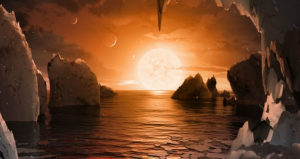Ever since its discovery in 2017, the TRAPPIST-1 system has fascinated astronomers — and for good reason. The seven alien planets that orbit this nearby tiny star have provided us with an incredible opportunity to study a neighboring solar system — one that is both similar to and very different from our own.
The Star
Located 39 light-years (or 235 trillion miles) from Earth, in the Aquarius constellation, this alien solar system revolves around a red dwarf star dubbed TRAPPIST-1. Classified as an M dwarf star, TRAPPIST-1 is a lot smaller than our sun — and about 2,000 times less bright, as previously reported by the Inquisitr.
In fact, TRAPPIST-1 is so small it barely makes the cut as a star, notes Phys.org. This tiny red dwarf weighs 9 percent of our sun’s mass and measures about 12 percent of its radius — which makes it only a little larger than the gas giant, Jupiter.
The Planets
The seven exoplanets that make up the system — named TRAPPIST-1b through TRAPPIST-1h — are all rocky, Earth-sized planets that have piqued astronomers’ interest, emerging as strong candidates in the search for life beyond our planet’s borders.
The immense appeal of the TRAPPIST-1 exoplanets has increased exponentially ever since it was discovered that three of these planets — TRAPPIST-1e, f, and g — orbit in the star’s habitable zone. This means that they sit close enough to their parent star for surface temperatures to allow the formation of liquid water — and potentially to give life a chance at evolving.
Read more HERE
Ask me anything
Explore related questions





